NFL DRAFT 2021 - SMALL SCHOOL WIDE RECEIVER RANKINGS
By Rebecca Rennie
Very few small school prospects were able to produce game film in 2020. Most teams are set to play this spring with many seniors also choosing to return for one more season of eligibility.
That said, this is shaping up to be a promising class of small school talent for the 2021 NFL Draft. As with last season, I will again attempt to discuss as many of these players as possible. It will unlikely be as deep as the Top 150 small school draft board of last season.
Hopefully, however, this year’s version will be better, regardless. There were some mistakes made in the process last season, the first attempting such a venture. There is always room for improvement!
After featuring small school Offensive Line prospects in the previous article, we now focus on some talented athletes at the wide receiver position:
1. Cade Johnson, WR, South Dakota State. Grade: 4th Round
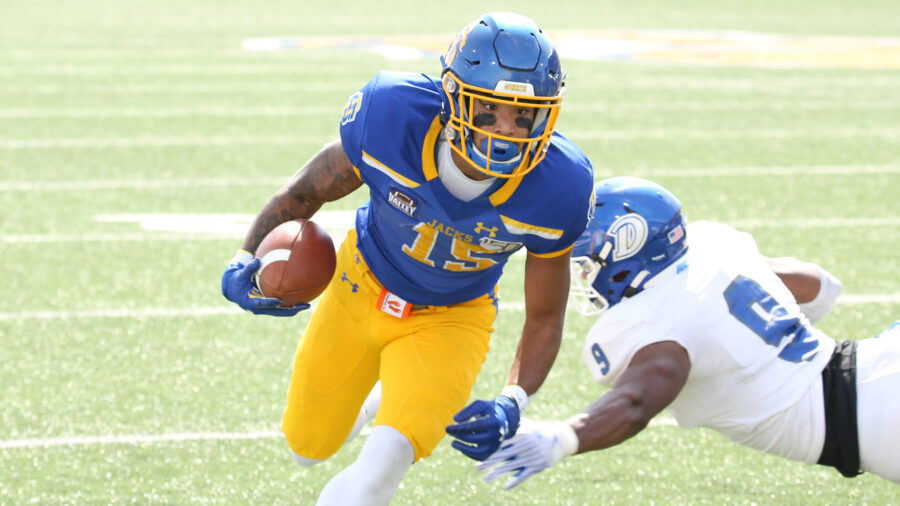
Height: 5’10”. Weight: 186 lbs.
Pros: With eight straight playoff appearances, the Jackrabbits are a leading FCS program, featuring a strong offense. Over the past twenty years though, Eagles tight end Dallas Goedert is the lone offensive draft pick out of SDSU. That surely changes in 2021 however, with Johnson looking worthy of a mid-round selection. The standout small school receiver may lack size but ticks most other boxes.
Johnson has put together two seasons of proven production and dominance over the competition faced. He backed that up by excelling against a higher talent level at the Senior Bowl. The former walk-on consistently separated from coverage over the week and finished at the catch point. His high positional IQ and quick-twitch athleticism rounds out the skills set on offer. A dynamic returner, he brings added special teams value.
Johnson excels at getting open through his suddenness in short areas, burst and sharp footwork. Adding in the combination of route-running savvy and situational awareness contributed to his consistently high production. From his initial acceleration off the line to dropping his hips and effectively breaking down at the top of his routes, he is tough to keep in check. The Jackrabbits receiver stands out for his ball tracking, hand-eye coordination, timing and reliable hands.
A factor all over the field, Johnson impresses as a downfield target on deep passes, making plays over the middle, taking short receptions and running after catch. He finds space versus zone defense as effectively as he works off man coverage. Executing a varied route tree, he contributes with chain-moving quick-hitters and breaking big-gain plays. Johnson transitions efficiently into a ball carrier after securing the catch. In addition to separating as a route runner, he shows the shiftiness to make defenders miss as a runner with the ball in his hands.
Though small, there is no questioning the toughness that Johnson plays with. He’s a high effort blocker when asked and shows no fear catching in traffic. The regularity with which he outfought bigger DBs at the catch point is noteworthy. Prior to becoming the leading target, the FCS All-American returned two kicks for touchdowns as a freshman.
Cons: While he makes up for it elsewhere, Johnson’s frame will likely limit how early he is drafted. In addition to being under 5’10, he measured in at the Senior Bowl lacking ideal length. His 29” arms and 71.5” wingspan results in a reduced target window and catch radius on offer. Though tricky in space and willing to take hits, he also has a limited physical presence. Johnson is unlikely to break too many tackles at the NFL level once defenders get contact on him.
Wrapping Up: After initially considering a Power 5 transfer following the cancellation of SDSU’s 2020 season, Johnson chose instead to enter the draft. While scouts might have liked to have seen that happen, he impressed vs Minnesota in 2019 and stood out consistently at the Senior Bowl. His smart instinctive execution, sharp movement and outstanding hands will offset some concern over his smaller frame. An early Day 3 pick should yield a fantastic return on investment.
2. Mike Strachan, WR, Charleston. Grade: 6th Round
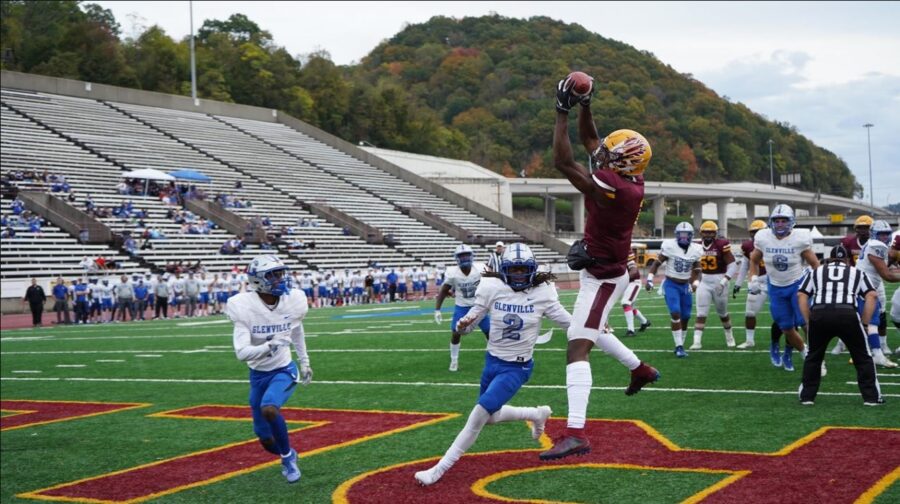
Height: 6’4”. Weight: 225 lbs.
Pros: Not many from Division 2 find a path to the NFL but Strachan has the physical frame that is assured to draw interest. The general caveat typically applied to players at that level to immediately stand out above others and to dominate the competition are conditions comfortably met. The physical mismatches were routinely evident on film as Strachan compiled tangible production. His 2019 season included 78 receptions for 1,319 yards (16.91 average) and an eye-opening 19 touchdowns.
Self-aware, Strachan has acknowledged being highly raw early in his college career. He has worked on improving his route running in particular, though it is still a work-in-progress. He has seen some varied usage at Charleston, lining up on both sides of the line of scrimmage, working deep downfield and on shorter targets crossing over the middle of the field. His impact as a big-play threat included averaging almost 21 yards a catch in 2018. A track athlete, Strachan’s long speed is proven as the school record holder at 400m.
A large proportion of Strachan’s wins heavily involve maximizing his physical advantages. He understands how to utilize his strength on contact from press coverage and control his route path. The Golden Eagles receiver may not consistently shake coverage but takes ownership of the catch point. Strachan uses his size and power as he positions himself relative to the DB. His expansive catch radius and ability to high point over most corners is a matchup that he will generally win. He frequently draws defensive pass interference calls and eagerly applies himself as a blocker for teammates.
Cons: Though he has worked on improving technically, Strachan has a long way to go in many aspects of his receiving skills. His release, footwork and hand use do not consistently compliment his physical abilities when working off coverage. Route running remains rough, including lost momentum in his breaks at the top of routes and some unsubtle sells.
There is clear top-end speed to pull away from D2 defenders once opening his stride in straight-line situations. That said, despite the track background, he can require a bit of a wind-up to reach his peak speed. Strachan is absolutely able to win out at the catch point but separating consistently isn’t there as yet. As he develops though, it’s easy to envision being difficult to stop should his overall game improve.
Wrapping Up: Strachan clearly has well-defined and desirable physical traits centered around his size, length and strength. A developmental project, he has so much potential if his technique can be sharpened up. His position across draft boards likely will vary dependant on the level of optimistic outlook. Regardless, it would be a surprise if he did not hear his name called at some stage during Day 3.
3. Keyion Dixon, WR, Eastern Kentucky. Grade: 7th Round
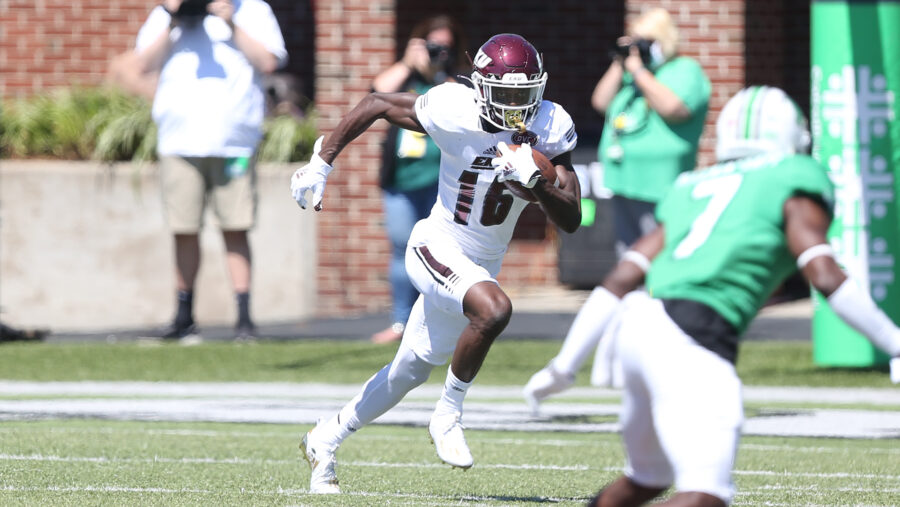
Height: 6’2”. Weight: 190 lbs.
Pros: Dixon has been a popular figure on the NFL Draft All-Star circuit, including participating in the Tropical and Hula Bowls. A UConn transfer, Dixon is a well-rounded athlete who impressed as a hurdler on the track in high school. At that level he featured at quarterback, wide receiver and defensive back, and ran for over 1,500 yards as a high school senior. His college freshman season showed promise at Connecticut but transferred to Eastern Kentucky after a reduced role as a sophomore. Despite some passing game limitations in the Colonels offense, he was able to showcase his abilities at the FCS level.
Dixon is an appealing blend of frame and athletic traits. He offers a lean but toned physique and good length at 6’2” with over 32” arms. A smooth, flexible and fluid mover, Dixon impresses with his releases and quick acceleration. In addition to the initial upfield burst, there’s good top speed, eating up yardage once opening his stride. Faced with press, off, man and zone coverages, he generally copes with each sufficiently.
What frequently stood out from Dixon’s film was his releases and polished hand use off the line. He consistently finds ways to win, effectively deflecting contact and taking the early initiative. The Colonels receiver uses extension and swim moves as part of his attempts to establish separation quickly. Often an area under-developed among college prospects, Dixon appears more nuanced than many in this facet of his execution. This gives some encouragement for his game to translate, alongside his overall IQ and situational awareness.
The base-level athleticism allows for impact on multiple levels of the field. He is frequently featured on short targets, over the middle, and downfield. Dixon has shown he can work well as a runner after the catch, including a good feel for space and zones. He demonstrates sharp footwork, changing direction with minimal wasted motion at the top of routes. Though he’s shown inconsistencies with hands, he is capable of some impressive catches outside of his frame and offers a good target window.
Cons: As hinted above, the primary negative with Dixon is a frustrating lack of consistency at the catch point. For every solidly secured reception, there is often a missed opportunity to match. There are a few too many instances of being off with his ball tracking and hand timing. When unable to separate and faced with contested situations, he can be distracted on occasion by tight coverage.
The former 2-star recruit will likely be asked about his drop off in production while competing at the FBS level. UConn has not been the most conducive environment to playing tier one football in recent years. He may well have satisfied those questions when speaking to scouts and personnel in his interviews, however. A class of 2015 recruit and redshirt senior, Dixon is a slightly older prospect.
Wrapping Up: It’s easy to be underwhelmed by Dixon’s modest production numbers (115 catches in four seasons). The traits on film suggest a skill set better than the stats that can work in a rotational role at the pro level. QB play at Eastern Kentucky factored into some opportunity limitations with the Colonels. Dixon has intriguing length and athleticism alongside some technical refinement. Were he more consistently convincing at the catch point he could have garnered a higher grade.
4. Donnie Corley, WR/DB, Texas Southern. Grade: UDFA
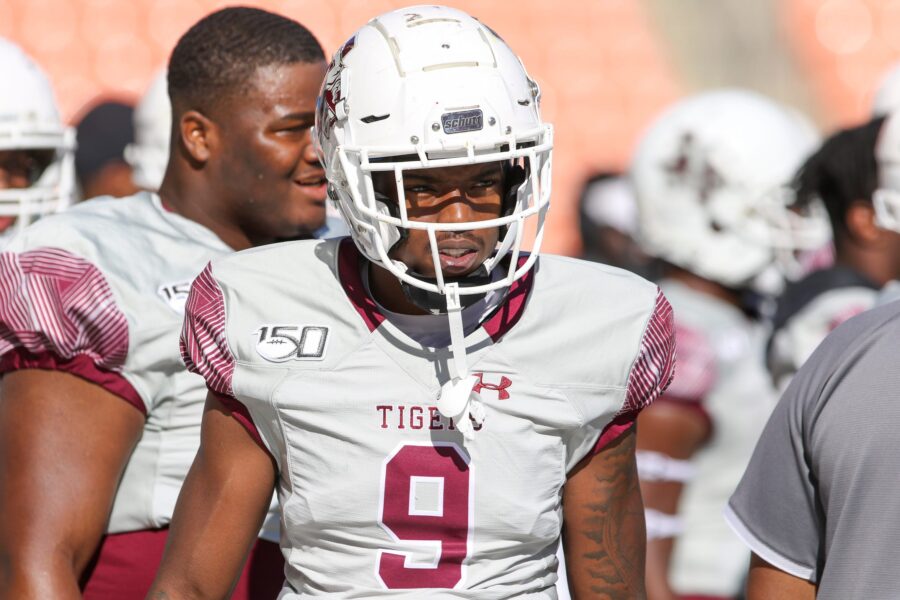
Height: 6’1”. Weight: 190 lbs.
Pros: A former 4-star recruit, Corley was coveted by numerous top programs before settling on Michigan State. He quickly established himself at the college level with an impactful freshman season with the Spartans. Off-field trouble led him to his exit and a second chance at Texas Southern, where he produced well. His most recent season in 2019 included 72 receptions for 1,039 yards and 3 touchdowns.
Corley is lean and athletic with quick releases from a standing start. He shows a good combination of footwork and burst over short areas to go with long speed. The Tigers receiver is fluid navigating the field and maintains speed as he makes his breaks. A standout at both the Tropical Bowl and Hula Bowl, he received praise at the latter as the best route runner on his All-Star squad. The abilities are present to separate at the NFL level, making it challenging for defensive backs to keep in phase.
The Spartans transfer has his share of impressive catches on film. Some standout examples include securing the ball in tight windows over the middle. He shows toughness in traffic to complete catches while facing an incoming hit. Good positional awareness sees him adjust well to keep his feet in bounds on sideline targets. His athletic pluses are put to use to pull away from DBs on deep targets and to work after the catch as a runner.
Cons: Character concerns are at the forefront of the questions regarding Corley. He was dismissed from Michigan State following allegations of rape alongside two former teammates. This was denied, while pleading guilty to felony seduction charges. He will inevitably be required to answer questions over the situation. Should he satisfy those queries, he can earn a pro opportunity based on his on-field abilities.
Corley is not without some issues on film also. While he has impressive catches to cite, there are a number of frustrating drops. The variance includes some focus-related drops and examples of looking to turn upfield early prior to securing the ball. His skill set is applicable to a diverse route tree but ran limited routes with the Tigers. His numbers were assisted by a good number of short, friendly targets.
Wrapping Up: It would not be a surprise if Corley is off the board for some teams. Ultimately, he could go undrafted regardless. If that’s the case, he could earn a roster spot or practice squad role as a free agent in training camp. Corley was also listed at the Tropical Bowl as a WR/DB with some experience at the latter position. This would suggest he may also be getting some consideration on the defensive side of the ball.
5. Kevonta Moses, WR/TE/FB, Shaw University. Grade: UDFA
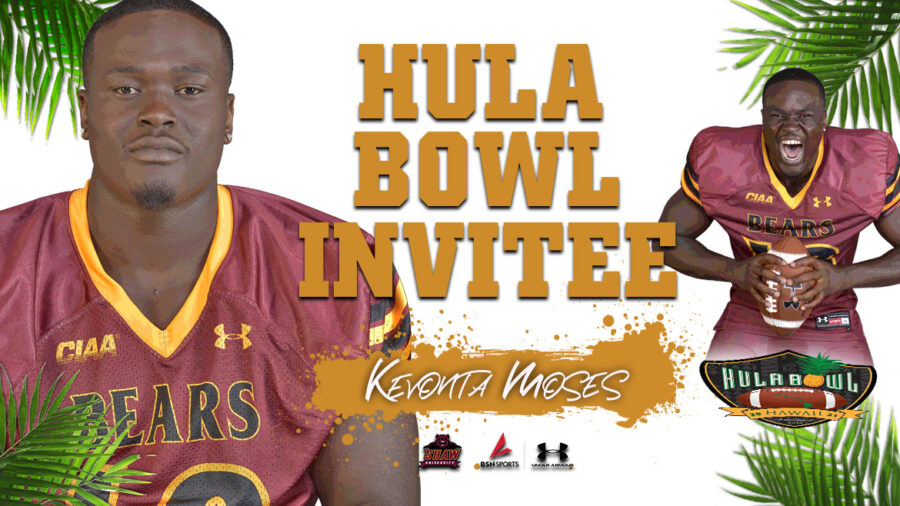
Height: 6’0”. Weight: 240 lbs.
Pros: A Division 2 prospect, Moses played two seasons at Shaw after a transfer from Dakota College at Bottineau Community College. Moses is among a group of small school receivers who all attended both the Tropical and Hula Bowl All-Star events. He was also invited to the HBCU Combine. The 2nd team All-CIAA selection totalled 37 receptions for 510 yards (13.8 average) and 9 touchdowns in 2019. Primarily a tight end at Shaw, he played mostly that role at the Hula Bowl, but largely at receiver at the Tropical Bowl.
The Shaw standout has the potential to be used at receiver, tight end, full back and on special teams at the next level. He features a powerful, broad build that he utilizes well. Moses plays with strength and balance, making effective use of his base, core, leverage and relatively lower center of gravity. Moses imposes himself as a route runner and as a runner after the catch. While his toughness invariably impresses, he also shows smart execution, footwork and polish, compensating for modest burst. He shows a good sense of space over the middle where he sees most of his targets.
The Bears’ versatile weapon has superb hands, and film frequented by outstanding high-difficulty catches. He is adept in snatching the ball outside of his frame, off-target throws from behind and one-handed highlight grabs. More conventional receptions see Moses track the ball instinctively and catch well in stride. He is equally as tough to disrupt at the catch point as he is to bring down by a single defender when he gets going with the ball in his hands. A nasty blocker, Moses works well both inline and as a lead blocker. He often overpowers and drives defenders back effectively.
Cons: Moses has an unconventional frame and length for wide receiver and tight end. An H-Back and full back role could be a projected best fit. He can absolutely excel in such a role and as a talented pass catcher but might have fewer teams available who will properly make use of his versatility.
His game is based more around power and sound technique than dynamic movement. Good footwork helps, but Moses isn’t the most explosive or laterally agile. Routes and releases are well executed but somewhat limited by acceleration and burst.
Wrapping Up: Special teams and depth at several spots could earn Moses roster spot. His film is lively and compelling, featuring physicality and flashes of playmaking. An established NFL contributor such as Anthony Firkser of the Titans comes to mind as a possible positive comparison for Moses to emulate.
6. Donte Sylencieux, WR, Graceland. Grade: UDFA
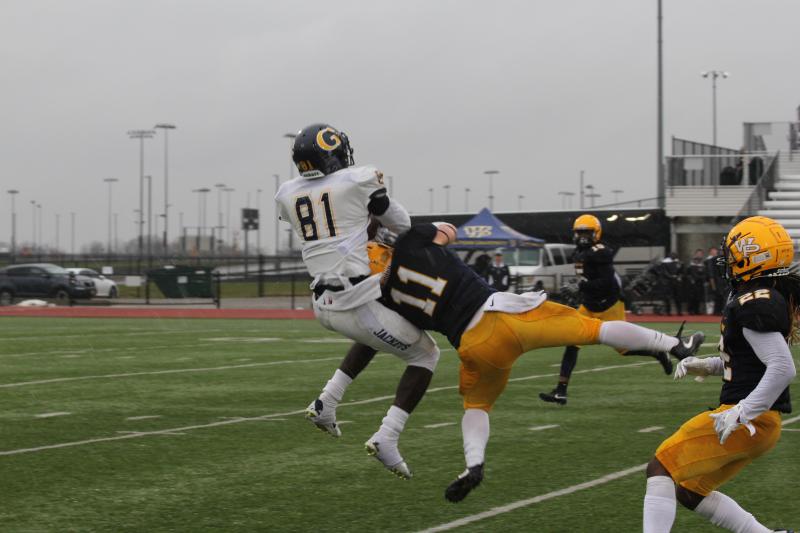
Height: 6’2”. Weight: 185 lbs.
Pros: A quick search on Pro Football Reference reveals two former Graceland alum with NFL experience. Sylencieux is a relative longshot to be the third but has potential with speed as his avenue to an opportunity. He could be a special teams standout as a gunner and returner. On offense, Sylencieux has been a big play threat including averaging over 27 yards a catch in 2018. Though very raw and unpolished technically, he looks so natural in other aspects of his receiving abilities.
The NAIA athlete routinely outpaces the lesser competition with acceleration and straight-line long speed to separate. He will run some shorter routes but is at his best stretching the field. The combination of speed and QB limitations leads to having to adjust and work back to the occasional underthrown pass but does so comfortably to bring in some difficult catches.
As desired of a deeper target, Sylencieux tracks the ball nicely with timing and ball skills at the catch point. Though very wiry, Sylencieux shows good concentration catching in traffic. His springy lower-body explosion and decent arm length provide a solid catch radius to target. The Yellowjackets receiver rarely fails to come down with the ball when within his reach.
Cons: Unlike most small schools, Graceland did play five games in 2020. Sylencieux only appeared in two of those games, however, with just 6 receptions for 77 yards and no scores. In addition to facing a steep learning curve and step up in competition, Sylencieux has much development required technically. Not currently a factor on all levels, his route running in general is a work-in-progress.
Footwork, hand use, route pacing and breaks can improve to compliment his separation quickness. At present, he can be disrupted off his route path by physically aggressive coverage in counteracting his speed.
Wrapping Up: There’s flashes on film that are really eye-opening. Sylencieux has excellent hands to go with NFL-caliber speed. It would be great to see him earn an opportunity in camp with so much untapped potential to work with. The potential to factor on special teams could buy him some time as he learns.
7. Dre’Sonte Dorton, WR, Eastern Washington. Grade: UDFA
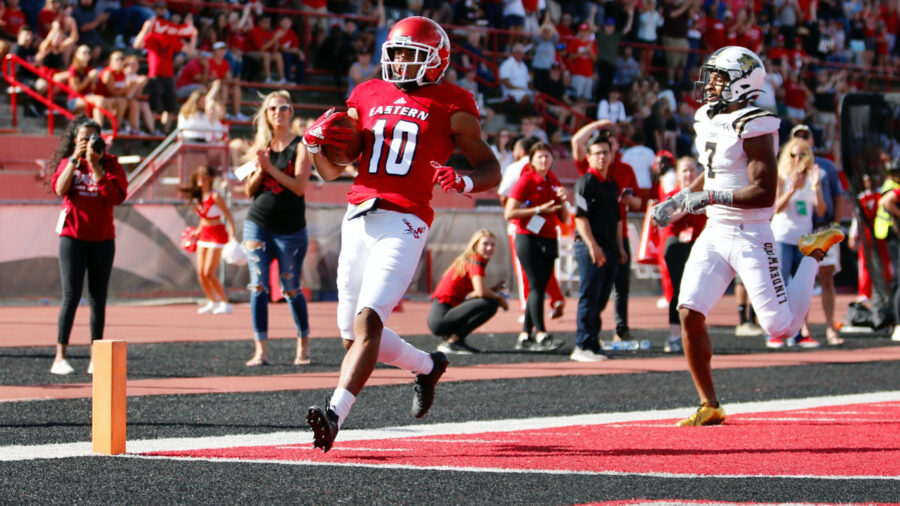
Height: 5’9”. Weight: 187 lbs.
Pros: Previously wearing #87, Dorton took on Cooper Kupp’s famous #10 jersey for Eastern Washington’s 2019 season. He proceeded to break Kupp’s single game receiving record with 15 receptions for 289 yards and 3 touchdowns against Lindenwood in the second week of the season. It was a breakout performance after mostly being a special teams ace during his college career.
Should he extend that career as a pro, his potential as a returner will likely be what earns a roster spot. Dorton has returned a pair of kicks for touchdowns and averaged over 27 yards a return in 2017. While not a truly elite burner, Dorton has good burst and agility, aided by sharp footwork and changes of direction.
The footwork and body control are arguably the most impressive areas of his game. There is very little wasted motion, exploiting subtle shoulder shifts and rocker steps as he sells his routes. Working tempo into his routes, his short area quickness proves effective as he breaks, notably on comebacks. The vision and balance that aid him as a returner also comes into the play as a runner after the catch.
Cons: Despite the 15-catch game referenced above, Dorton only finished the 2019 season with 27 total receptions. He entered that season listed as a backup on the depth chart and concerningly struggled to break into the offensive rotation earlier. After redshirting in 2015, Dorton did not feature in 2016 either. He had minimal receiving contributions in 2017 and 2018 (10 and 6 catches respectively).
The Eagles receiver has an undersized frame. He could establish himself as a useful slot receiver and underneath target but most likely will need to solidify returner duties to secure his place on the team. Entering college in 2015, he is a little older than the majority of his 2021 class peers.
Wrapping Up: Dorton is a tidy route runner who is at his best with the ball in his hands. Showcasing his vision and balance with the ball in his hands as a receiver and returner could give him an outside chance. Modest production and the small frame are concerns, however.
Feature Image Credit: South Dakota State University Athletics

rebecca rennie
CFB/NFL DRAFT analyst
Rebecca is an NFL Draft analyst focusing primarily on the FCS and Group of Five conferences, and a fan of both the Tampa Bay Buccaneers and Stanford Cardinal. You can find her other articles here and follow on Twitter @bex_r86.
